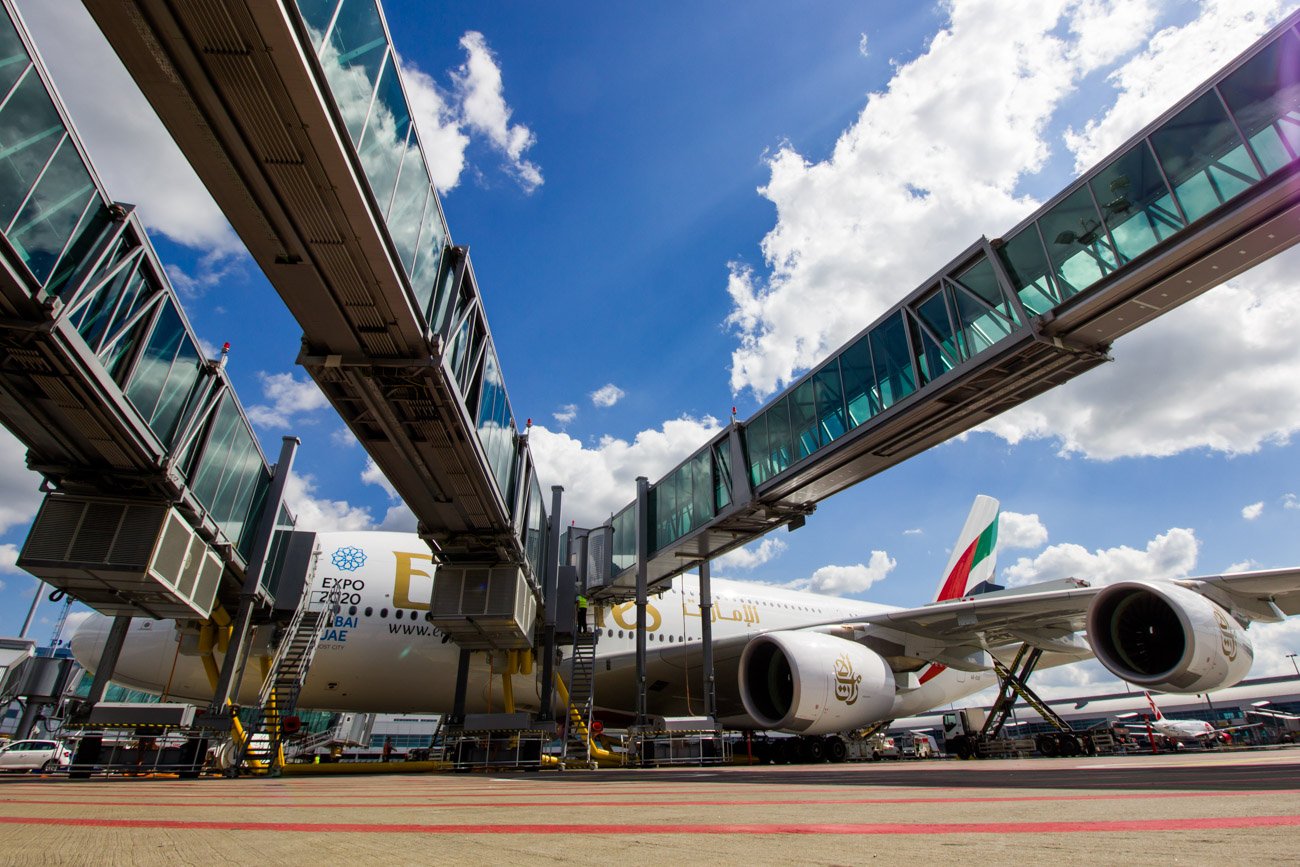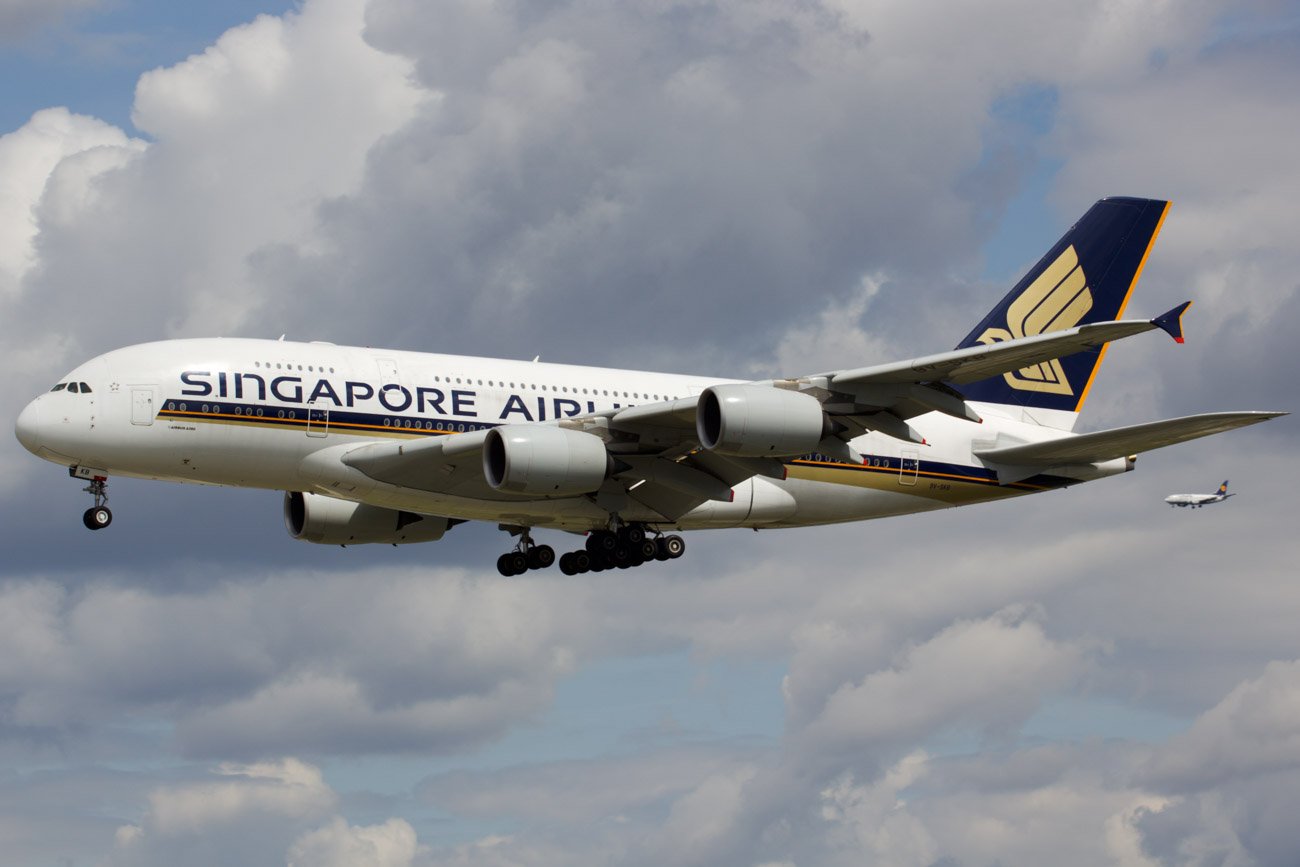The A350 and A380 widebodies are very different aircraft physically. The A350 is relatively new on the scene, first entering commercial service in 2015, and remains in full production. The A380, on the other hand, has been around for 15 years and its production run has ended with the last A380 rolling off the production line in 2021.
In this article, I’ll compare these two aircraft from a number of different perspectives. So, let’s see how these two long-haul widebody Airbus aircraft compare in terms of key attributes such as size, seating capacity, range, and orders.

History
The A350 family has two passenger versions: the A350-900 and the longer fuselage A350-1000. A freighter version, the A350F is available too. Lastly, the A350 is also available as an Ultra Long Range model (A359-900XWB) which is externally identical to the A350-900 but has an increased fuel capacity and increased MTOW.
The A350 variants are listed below:
| Variant | Type | Entry into Service |
| A350-900 | Passenger | 2015 |
| A350-900XWB (Ultra Long Range) | Passenger | 2018 |
| A350-1000 | Passenger | 2018 |
| A350F | Freighter | – |
The Airbus A350 was initially conceived to compete with Boeing’s 787. The first A350 prototype flew in June 2013, and received type certification from both EASA and the FAA in 2014. The A350 is the first Airbus aircraft largely made of carbon-fiber-reinforced polymers.
The A350F freighter version is available for order, but as of November 2022, no A350F aircraft have been delivered. In January 2015, the first A350-900 entered service with Qatar Airways, followed by the A350-1000 in February 2018, also with Qatar Airways.
The A350 succeeds the A340, and competes with Boeing’s long-range aircraft, in particular the 787, 777 (see how they compare), and 777X.

The A380 is no longer in production and was available in just one variant, the A380-800. Other variants were proposed but never produced, including the A380 Freighter (A380F), the A380-200 or ‘A380 Stretch,’ the A380-900 (another stretched variant), the A380neo (stretched, new engines and higher passenger capacity), and the A380plus (higher seat capacity and improved fuel efficiency).
The A380 is the world’s largest passenger airliner and the only full-length double-deck commercial passenger aircraft. Airbus originally conceived the initial idea for the A380 back in the late 1980s and it was developed as a direct long-haul competitor to the Boeing 747. The A380 program was not launched until 2000, and the first prototype was produced in Toulouse, France in 2005. FAA and EASA type ratings were received in 2006.
The first A380 deliveries were delayed and took place in 2007, with Singapore Airlines being the launch customer. At its production peak, Airbus was able to produce thirty A380s a year.
The A380s largest customer is Emirates with 123 deliveries. In 2019, Emirates canceled part of a large order, and subsequently, Airbus decided to end the A380’s short-lived production run. The final, 251st A380 was delivered to Emirates in 2021.

Dimensions
Let’s take a look at some key physical characteristics and see how the passenger versions of these two aircraft measure up against each other. As you would expect, the double-passenger deck A380 is significantly heavier than the single-passenger deck A350 and has a wider diameter fuselage. The A380 also has a longer wingspan than the A350 variants. However, whilst the A380 is longer than the A350-900, it is shorter than the A350-1000.
The A380 is classified as an FAA Group VI aircraft because of its long wingspan. Whereas, the A350 variants are the smaller Group V. Group VI includes aircraft with wingspans between 65m and 80m. Group V included aircraft with wingspans between 52m and 65m.
| Aircraft Model | Length/ m | Wingspan/ m | Fuselage Width/ m | MTOW/ tonnes |
| A350-900 | 66.80 | 64.75 | 5.96 | 283.0 |
| A350-1000 | 73.79 | 319.0 | ||
| A380 | 72.72 | 79.75 | 7.1m | 575.0 |
Range
The A350 is flexible enough to fly efficiently all sectors from short-haul to ultra-long-haul routes, with a maximum range of up to 9,700nm for the A350-900XWB allowing more than 20 hours of flying time. The A350 was developed to compete directly with Boeing’s long-range aircraft, specifically the 777 and the 787.
The ranges of the A350 variants are shown in the table below.
| Aircraft Model | Range |
| A350-900 | 8,300nm (15,372km) |
| A350-900ULR (A350XWB) | 9,700nm (18,000km) |
| A350-1000 | 8,700nm (16,112km) |
Airbus indicates that the A380 has a range of 8,000nm (15,000km), with a standard 4-class cabin configuration. This is comparable to the A350 standard variants but lower than the A350-900ULR.

Seat Capacity and Cabin Layout
The A350 typically carries anywhere between around 250 and 400 passengers in two- or three-class cabin configurations.
I have looked at the seating configurations of this aircraft’s biggest customers currently operating A350s (Singapore Airlines, Lufthansa, Air France, Qatar Airways, Etihad, Air China, Virgin Atlantic, and Cathay Pacific). Typically, this aircraft is configured with three-class or two-class seating configurations, and the ranges of seat numbers are set out in the table below:
| Aircraft | 2-class | 3-class |
| A350-900 | 161 – 303 | 253 – 325 |
| A350-1000 | 327 | 331 – 397 |
You can see that seating numbers vary significantly even for the same aircraft with the same number of cabins. The two-class configuration with 161 seats belongs to Singapore Airlines’ A350-XWBs used on its long-haul routes to the USA which are fitted out with only business and premium economy class seats.
Airbus suggests that the A350 can carry 300-350 (A350-900) or 350-410 (A350-1000) passengers in typical three-class configurations, and up to 440 passengers in a single-class layout for the A350-900, and 480 passengers for the A350-1000.
The A350 interior typically allows cabin configurations of nine seats per row in economy class, eight seats per row in premium economy, and four seats per row in business class, with a twin-aisle arrangement.
Airbus indicates that the A380 allows 545 seats in a standard 4-class configuration and a maximum seating capacity of 853. The maximum 4-class configuration currently operating is 520 seats.
For the A380 I looked at the seating configurations of all current A380 operators. Typically, this aircraft is configured with three or four-class cabin configurations, with one airline (Emirates) operating a two-class configuration (business and economy classes) on some of its aircraft. The average seat numbers for each cabin configuration are set out in the table below.
| Aircraft | 2-class | 3-class | 4-class |
| A380 | 615 | 495 | 488 |
The twin-aisle A380 interior typically allows cabin configurations of ten seats per row in economy class – lower deck, and eight seats per row in economy class – upper deck. Premium economy is typically seven, or eight seats per row, depending on which deck is used. Business class typically has four to six seats per row (with eight seats abreast in British Airways’ opposing seat layout), and first class has three or four seats per row.
Customers and Orders
To the end of November 2022, Airbus has received a total of 919 orders for the A350 and delivered 509 of those (55%). So far, the A350-900 is the most popular of the A350 variants accounting for 81% of orders and 87% of deliveries.
The top customers for the A350 (all variants) are shown in the graph below.

The A380 is no longer in production and Airbus received a total of 251 orders from fourteen airlines – Air France, ANA, Asiana, British Airways, China Southern, Emirates, Etihad, Korean Air, Lufthansa, Malaysia Airlines, Qantas, Qatar Airways, Singapore Airlines, and Thai Airways.
Emirates is by far the A380’s largest customer, accounting for almost 50% of the total orders. Singapore Airlines is the second largest customer accounting for around 10% of orders.

A350 vs. A380: Summary
The A350 and A380 widebody stable mates are, physically, quite different aircraft. The much larger A380, with its two decks, is heavier, wider, carries more passengers, and has a longer wingspan.
The A380 is no longer in production and had a delivery run from 2007 to 2021. In contrast, the A350 was first delivered in 2015 and remains in production today. So far, Airbus has delivered only 55% of the total A350 orders received by the end of November 2022.
In terms of commercial success, it can be said that the A350 is a more successful aircraft than the A380 with almost four times as many A350 orders as A380 orders. Given the popularity of the A350 to date, there are likely to be many more orders to come for this aircraft.
